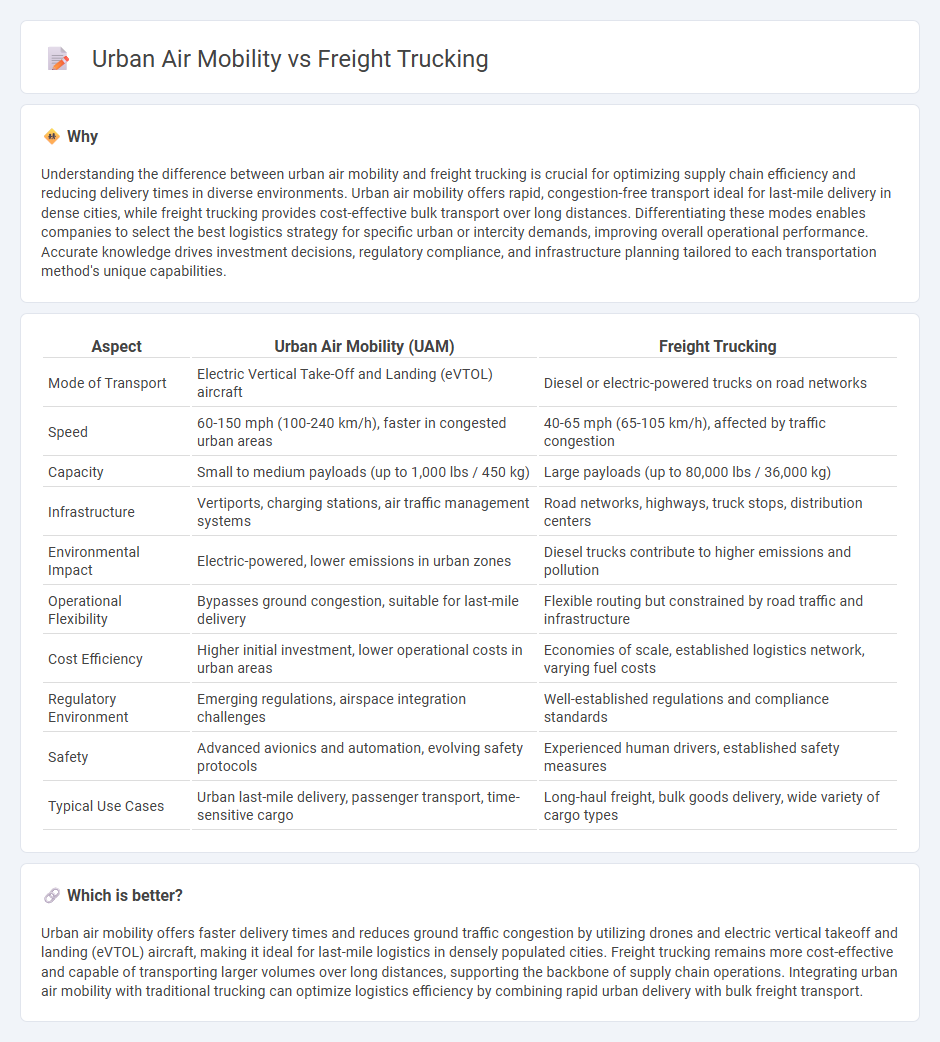
Urban air mobility revolutionizes freight logistics by enabling rapid, efficient transport across congested cityscapes, reducing delivery times and minimizing road traffic. Freight trucking remains essential for ground-based cargo transport, offering extensive network reach and high payload capacity. Explore how these two modalities shape the future of urban freight distribution and logistics innovation.
Why it is important
Understanding the difference between urban air mobility and freight trucking is crucial for optimizing supply chain efficiency and reducing delivery times in diverse environments. Urban air mobility offers rapid, congestion-free transport ideal for last-mile delivery in dense cities, while freight trucking provides cost-effective bulk transport over long distances. Differentiating these modes enables companies to select the best logistics strategy for specific urban or intercity demands, improving overall operational performance. Accurate knowledge drives investment decisions, regulatory compliance, and infrastructure planning tailored to each transportation method's unique capabilities.
Comparison Table
| Aspect | Urban Air Mobility (UAM) | Freight Trucking |
|---|---|---|
| Mode of Transport | Electric Vertical Take-Off and Landing (eVTOL) aircraft | Diesel or electric-powered trucks on road networks |
| Speed | 60-150 mph (100-240 km/h), faster in congested urban areas | 40-65 mph (65-105 km/h), affected by traffic congestion |
| Capacity | Small to medium payloads (up to 1,000 lbs / 450 kg) | Large payloads (up to 80,000 lbs / 36,000 kg) |
| Infrastructure | Vertiports, charging stations, air traffic management systems | Road networks, highways, truck stops, distribution centers |
| Environmental Impact | Electric-powered, lower emissions in urban zones | Diesel trucks contribute to higher emissions and pollution |
| Operational Flexibility | Bypasses ground congestion, suitable for last-mile delivery | Flexible routing but constrained by road traffic and infrastructure |
| Cost Efficiency | Higher initial investment, lower operational costs in urban areas | Economies of scale, established logistics network, varying fuel costs |
| Regulatory Environment | Emerging regulations, airspace integration challenges | Well-established regulations and compliance standards |
| Safety | Advanced avionics and automation, evolving safety protocols | Experienced human drivers, established safety measures |
| Typical Use Cases | Urban last-mile delivery, passenger transport, time-sensitive cargo | Long-haul freight, bulk goods delivery, wide variety of cargo types |
Which is better?
Urban air mobility offers faster delivery times and reduces ground traffic congestion by utilizing drones and electric vertical takeoff and landing (eVTOL) aircraft, making it ideal for last-mile logistics in densely populated cities. Freight trucking remains more cost-effective and capable of transporting larger volumes over long distances, supporting the backbone of supply chain operations. Integrating urban air mobility with traditional trucking can optimize logistics efficiency by combining rapid urban delivery with bulk freight transport.
Connection
Urban air mobility integrates seamlessly with freight trucking by providing rapid aerial transport options that complement ground-based delivery networks. This synergy enhances last-mile delivery efficiency, reduces congestion on urban roads, and accelerates supply chain responsiveness. Advanced logistics platforms leverage data from both air and trucking sectors to optimize routing, minimize transit times, and lower operational costs.
Key Terms
**Freight Trucking:**
Freight trucking remains the backbone of logistics, transporting over 70% of all goods in the United States via a vast network of highways and distribution centers. With advancements in electric trucks and autonomous driving technology, the industry is improving efficiency and reducing carbon emissions. Explore how freight trucking innovations are shaping the future of supply chain management and urban air mobility integration.
Supply Chain
Freight trucking remains the backbone of supply chain logistics, dominating last-mile delivery and long-haul transportation due to its extensive infrastructure and cost-effectiveness. Urban Air Mobility (UAM) offers transformative potential by enabling rapid, congestion-free aerial cargo transport, particularly for urgent, high-value shipments within metropolitan areas. Explore how integrating UAM with traditional trucking can revolutionize supply chain efficiency and responsiveness.
Last-Mile Delivery
Freight trucking dominates last-mile delivery with established infrastructure and cost-effective large payload capacity, enabling efficient transportation across diverse urban and suburban environments. Urban air mobility introduces innovative drone and eVTOL solutions that reduce transit times and bypass ground traffic congestion, offering potential for faster, environmentally friendly deliveries in dense urban areas. Explore how these evolving modalities are transforming the last-mile delivery landscape.
Source and External Links
Types of Freight Trucks and What They Haul - Revolution Trucking - Explains different types of freight trucks, such as semi-trailers, flatbeds, and dry vans, and details how to choose the right truck based on cargo type, weight, distance, and cost considerations.
XPO - LTL Freight Quotes and Logistics Services - One of North America's largest providers of less-than-truckload (LTL) freight shipping, offering extensive networks, shipment tracking, and technology-driven freight optimization.
What is Freight shipping? How does it work? - FedEx - Covers freight shipping basics, including definitions, cost calculation, and options for LTL and air freight, highlighting benefits such as pallet tracking and simplified shipping processes without paper bills of lading.
 dowidth.com
dowidth.com